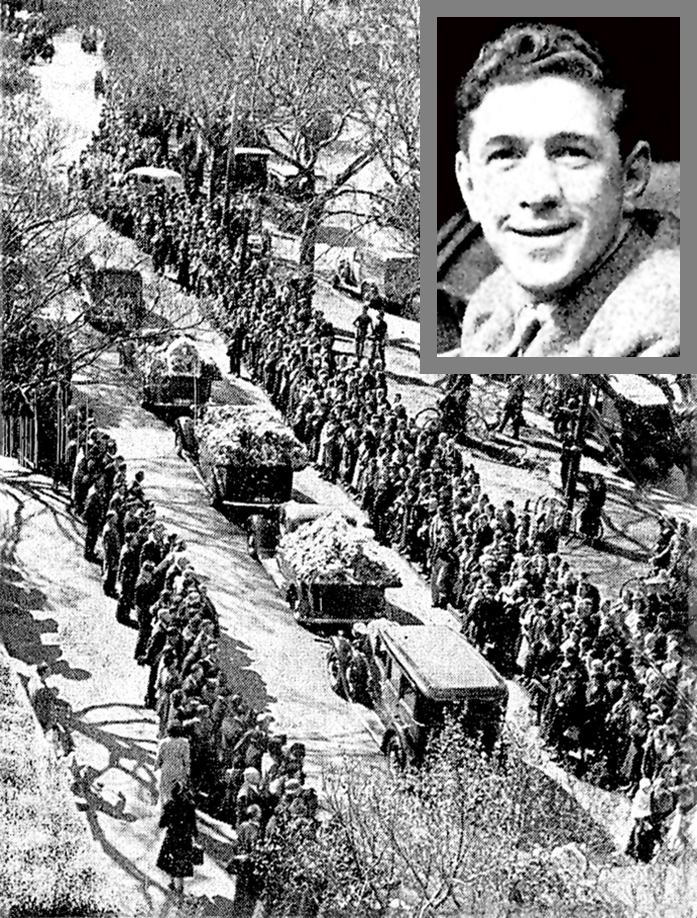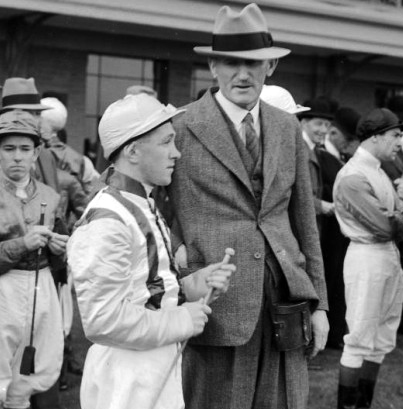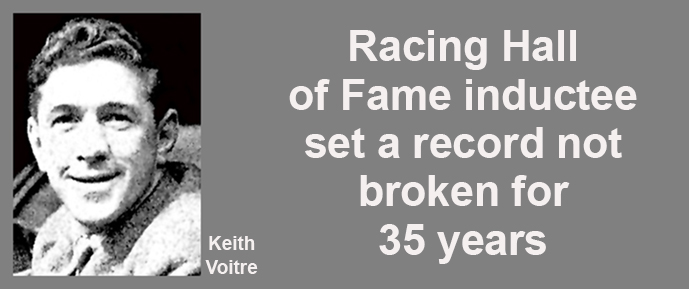by Brian de Lore
Published 5 May 2023
Every two years, a new group of high achievers come forward for induction into the New Zealand Racing Hall of Fame, and in the class of 2023, none would be more deserving of a place than the late Keith Felix Hawkins Voitre.
Not only did this young man display a genius rarely known in his profession, and perhaps posthumously never bettered in such a short career, but his perfection as a jockey came equally matched with an off-course behaviour that singled him out amongst his peers.
He exuded a manner, charm, and maturity well beyond his years. These qualities defined him as special, and consequently made his sudden, early death all the more tragic.
Keith’s genius in the saddle existed for only 10 years, between his first ride at the age of 15, and his last at Moonee Valley 10 years later on 10 September 1938, when through no fault of his own, three horses fell in front of Keith’s mount, Frill Prince, in the Budgeree Handicap, all of them ridden by apprentices, including Bill Williamson. The three sustained comparatively minor injuries.
Keith’s mount followed the three fallers and went down over them; he had no chance, suffered severe head injuries, and died on the operating table in Melbourne Hospital at 10 pm that night. Not long before the accident, he had become engaged to a local Melbourne girl.
The tragedy provoked an outpouring of grief on both sides of the Tasman never before known in racing or for someone so young. The sorrowful reaction to Keith’s death resembled that of the demise of a head of state, royalty, or highly respected world champion.

Keith Voitre’s funeral on 20 September 1938 drew thousands of mourners that lined
Melbourne’s St Kilda Road for the entire eight mile journey to Falkiner Cemetery
A Melbourne newspaper wrote: “Men and women of every class gathered in a great crowd this afternoon for the funeral of Keith Voitre. Not for many years has an assembly been seen at a Melbourne funeral. The crowd included leaders of the Australian turf, sportsmen of every rank, men who had ridden with Voitre, and thousands who had followed his career from the enclosure and hill.”
Hundreds of floral wreaths arrived from all parts of Australia and New Zealand. The Wanganui Chronicle described Voitre as the finest horseman ever developed in the Dominion, likening him to the human equivalent of Phar Lap, with his name known in every corner and sphere of the Dominion.
Traffic became gridlocked in Melbourne that funeral day on 20 September 1938 as thousands gathered densely on both sides of St Kilda Road for the entire eight-mile route to the Falkiner Cemetery, where they formed a packed square around the site of the grave.
After the service, thirty jockeys formed a guard of honour as the coffin with his Melbourne Cup presentation whip resting on top underwent careful lifting by the pallbearers to the carriage. Three floral cars followed the hearse, banked high with wreaths, with many tied in the colours of the owners for which Voitre had ridden. One wreath stood out conspicuously, made with pansies and violets in a horseshoe shape with the word ‘Resting’ in gold letters on a blue background.
“…people admired his many excellent qualities as a man…”
In a eulogy that appeared in The Sportsman three days before the funeral, after espousing his brilliance as a jockey, the author writing as ‘Chiron’ said, “He was a young man with a most pleasing personality and address, and for that reason, he was popular both in the racing world and out of it, as people admired his many excellent qualities as a man apart from his merits as a jockey.
“He was a credit to his calling, and his death will cause sincere regret in Victoria as well as New Zealand, where he was conspicuously successful before he came to Australia,” concluded Chiron.
The Keith Voitre story had begun more than 60 years earlier when his Polish immigrant grandfather, Felix Voitrekovsky, stepped off the ship Lammershagen in Wellington in July 1875.
On a website called Polish History New Zealand, historian Barbara Scrivens explained, “The Polish spelling of Felix’s name is Feliks Wojciechowski. Felix continued to use the Germanised version in New Zealand.”
The detailed Barbara Scrivens’ history of the Voitrekovsky family later in her account mentions Keith’s father Ernest. It stated, “Ernie loved all his children, and his children loved him. They called him ‘Pop,’ as did his own family, and when he died in 1958 in Auckland, many others besides his own mourned his passing.
“Keith’s early success as a jockey allowed him to help set up his father in business in the cordial factory at 65 Albert Street, Palmerston North.”
In 1928, Ernest moved his family to Wanganui where he changed his name to Voitre, after which Ernest’s niece, Florinda, speculated the change came for practical purposes for the benefit of Keith.
Much later, after Ernest moved the family back to Palmerston North, Florinda is credited with this comment made in 1942: “So successful was the firm by this time that Ernie was able to build a beautiful home. The residence contained a small room sacred to the memory of Keith. In it had been gathered together all his cups, prizes, photographs, and memorabilia, as well as his riding outfit, saddle, whip, etc.”

Keith Voitre’s whip that was placed on his coffin for the funeral service. It was presented to him following his 1935 Melbourne Cup win, and bears the inscription: Presented by Mr Philip Wirth Senior to Keith Voitre, rider of MARABOU, winner of the 1935 Melbourne Cup
Barbara Scrivens’ research revealed praise for Keith’s father. She said, “Ernest Felix Voitre, a ‘charming man,’ approached his fiftieth year with a secure marriage, six children, the words ‘Voitre and Sons’ outside his cordial factory in Palmerston North, and enjoyed following his son Keith’s career as a jockey – on 10 September 1938, Ernest’s world collapsed…”
Keith inherited his grandfather’s diminutive size, quiet demeanour, and his father’s loving nature, all of which played their part in his astounding rise to fame and cult-like following. All the qualities he displayed as a human being came from his veneration for his parents, which transmitted to an unswerving loyalty to the owners for whom he rode with a fearlessness that won him many races.
A midget at school, but a quick thinker with a very sharp brain, in standard VI he finished the year as dux of the school. As a 12-year-old, he had entertained the idea of becoming a bank clerk, but a year later at Otaki, as a 13-year-old, he became mildly interested in becoming a jockey. Before school, he led horses out in the mornings for the Penman stable but only ever rode a bombproof hack, his first experience atop a horse.
After a year, his father suggested an approach to a trainer for an apprenticeship. In 1927, aged 14, his mother took Keith to Roley Hatch’s stables, where the trainer took a liking to the young lad, and his jockey indentures commenced.
5 stone 2 pound (33kg) for his first race ride
At 14 years, the diminutive Keith weighed barely more than four stone (25kg), but Hatch immediately recognised his potential and put time into teaching him, correcting all his learner faults and increasing his confidence. Six months hence he had grown and strengthened and increased his weight to 5st 2lb (33kg) when he made his debut in an official race, finishing last in a five-furlong sprint at Woodville.
In a frank interview in Sport and Sportsman published after his Melbourne Cup success on Marabou in 1935, Keith Voitre said: “It was Roley Hatch who taught me how to balance my weight in the saddle and how to ride a well-judged race.”
“I won my first race at Carterton on Callanmore. I’ll never forget the thrill of feeling my mount striding along, well within itself and ahead of the field, with the winning post sliding smoothly towards me. Soon after, I won another race on Callanmore, and after little more than 12 months in the saddle, I had ridden 18 winners.
“The following year, I brought 32 of them home,“ continued Keith, “and in the next season, 48. By that time, I had knocked all the rough edges off my riding and had an easy seat in the saddle. But most of my races were ridden according to my trainer’s instructions, and his judgment played a big part in my success.
“In 1931, I made my first trip to Australia, still as an apprentice, but on loan from Roley Hatch to J. T. Jamieson. It was a fairly short visit, but I rode five winners, one of them at Randwick, and finished second in the Metropolitan on In the Shade. I went back to New Zealand, not realising that Australia would be my home for many years to come. Back home, I soon struck form again.

In the Flemington mounting yard before the 1935 Melbourne Cup,
Keith with former New Zealand trainer Lou Robertson discuss the
tactics for the winning ride on Marabou.
“In the Melbourne Cup, I could feel Marabou bowling along sweetly under me. I could have sung three furlongs from home when I realised he had a good chance. On the home turn, I began to push him to the front, and as we straightened up for home, I knew I had the race won.
“I’m sorry for the man who hasn’t had that magnificent feeling. It may be a Melbourne Cup or a novice handicap, but nothing can dull the thrill of the final dash to the judge when your mount is streaking along ahead, and the sound of the hooves behind is only a dull echo that the wind carries away.
“My happiest moments have come when I am crouching over my mount’s neck as he goes further and further ahead or else creeps up on the leaders. It is then that you get the feeling of speed, and 20 years in the saddle would not affect my liking for it.
“I never use the whip unless I am absolutely forced to it. Horses are magnificent animals, sensitive and highly strung, and no jockey worthy of the game would knock them about just for the fun of it.
“Usually, I can get all the speed I need out of my mount by using my hands, knees, and heels, and a horse urged on in this way is always likely to do better than one that is hit all the way home. Often a hard whack with the whip is enough to throw a horse out of its stride, so common sense and decency should make jockeys use their mounts as kindly as they possibly can.
“Being a natural lightweight, I am a whole heap luckier than many other jockeys. Normally I ride at about 7.11 (49kg), but I can get down to 7.7 without trouble. I have never been in a Turkish bath In my life, and I’ve never had to waste.
“In 1932, I rode over 80 winners. The next year I put up a New Zealand record with 123 wins, and it was then that they began talking about my riding skill.
“I can only explain my record-year by saying I rode just as well as I could, taking my opportunities as they came, judging my mounts’ needs as well as I could, and having my full share of the luck. And I was lucky, too, in the calibre of the horses I was engaged to ride.
“I came to Australia and have no cause to regret my decision”- Keith Voitre
“The next year, I came to Australia because both Sydney and Melbourne seemed to offer a good market for riding skills. I have had no cause to regret my decision. My greatest races have been ridden in Australia; in most of them, I have had to use every atom of my skill. But in none of them did I perform superhuman or magic feats. I just rode as well as I could, and the horses did the rest.”
Keith rode 420 New Zealand winners in just a few seasons at home, including two Auckland Cups on Admiral Drake and Gold Trail, two Great Northern Foal Stakes, the Great Northern Guineas, two ARC Welcome Stakes, two Avondale Stakes, the CJC Jockey Club Handicap, Members Handicap, Egmont Cup, Manawatu Sires’ Produce Stakes, Napier, Nelson Cup, two Rangitikei Cups, two Taranaki Cups, Wanganui Cup, Wairarapa Cup, Wellesley Stakes, Wellington Stakes, and Wellington Cup.
In the 1931-32 season he won the New Zealand Jockeys’ Premiership as an apprentice with 82 wins. The following season he broke Hector Gray’s 116-win record with 123 wins which stood for 35 five years until broken by Bill Skelton in 1967-68.
In the short time Keith Voitre had ridden in Australia, he scored many notable successes; his principal wins included the Doncaster Handicap on Hall Mark, Melbourne Cup on Marabou, Victoria Derby on Feldspar, Newmarket Handicap on Count Ito, Oaks Stakes on Nalda; Ascot Vale Stakes on Tactical, Williamstown Cup on Garrio, Epsom Handicap on Synagogue, and South Australian St Leger on Donaster.
Champion Australian Jockey Billy Duncan praised Voitre
Champion Australian jockey of the day, Billy Duncan, won 11 Victorian Jockeys’ Premierships between 1920 and 1933 and won the Melbourne Cup at his first ride in the race on Night Watch in 1918 as an 18-year-old and again 14 years later on Peter Pan in 1932. He watched Keith Voitre closely while sidelined with injury.
He said, “I have been told by owners, trainers, and jockeys that Voitre and myself are counterparts. After watching him closely, I should say that our styles are identical in many respects. Like me, he seems to like a good break out of the machine and is invariably found in the first three or four.
“I never liked to ride the type of horse that could not be up with the leaders without being bustled. Naturally, I have been a critical observer of Voitre and other jockeys since my fall from Rose Valais, and with glasses, look for happenings throughout a race that possibly others would not bother about. In Voitre’s case, I have been most exacting. I have taken into consideration the type of horse he has ridden, his barrier position, and the distance of the race. In my own mind, I have mapped out the race I would ride on that particular horse, and our ideas seem to coincide.
“Never flustered, he is in complete control of his mount, and his face always carries that confident, mean, business look. He is always ready to seize an opening; an alert brain and vigorous methods help him in this regard. Perhaps the only difference in our riding could be detected in the closing stages of a race. Voitre has a style entirely his own, and all said and done, his judgment and effectiveness in finishes leave nothing to be desired.
“He gets the best out of his mounts, and no one could do more. To build up such a glorious record in such a short space of time speaks volumes for Voitre. He has the world at his feet. A natural lightweight, strong, vigorous, brainy and cool, he should go on for years, and being a gentlemanly little fellow, he will make many friends in the right direction.”
Footnote:
The Melbourne Cup presentation whip, recently framed, came into my possession in unusual circumstances, and I feel privileged to be the custodian of such a historical object that represents Keith Voitre’s most important win.
Inscribed on the whip in brass, it says: “Presented by Mr Philip Wirth Senior, to Keith Voitre, rider of Marabou, winners of the 1935 Melbourne Cup.
In 1938 it was placed on Keith Voitre’s coffin for the funeral service and procession to Keith’s grave in Melbourne’s Falkiner Cemetary. It then went back to New Zealand with Keith’s parents and only returned to Australia on the 50th anniversary of Keith’s win on Marabou when his ex-jockey and trainer brother Noel returned to Melbourne in 1985 for the first time since Keith’s funeral.
Noel stayed with Brian and Jan Andrews, and Brian took him to visit Keith’s grave, and he went to the 1985 Melbourne Cup. He brought with him three scrapbooks kept on Keith to show to Brian and Jan and, upon leaving, gave Brian the whip. Since the passing of Brian, Jan had considered giving it to the Racing Museum in Melbourne but thought it really belonged in New Zealand.
Jan and I had occasionally discussed Brian’s riding accomplishments on Chat. One day she offered the whip to me and I accepted, and now I am its custodian (framed only last week), which is an honour, but the whip truly belongs in a New Zeland Racing Museum, which we currently don’t have.
Isn’t it about time racing people of influence formed a committee and did something about founding a racing museum?

